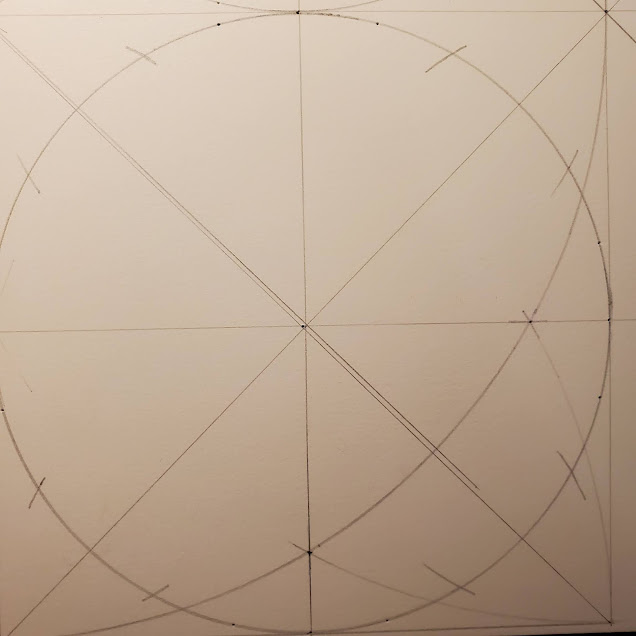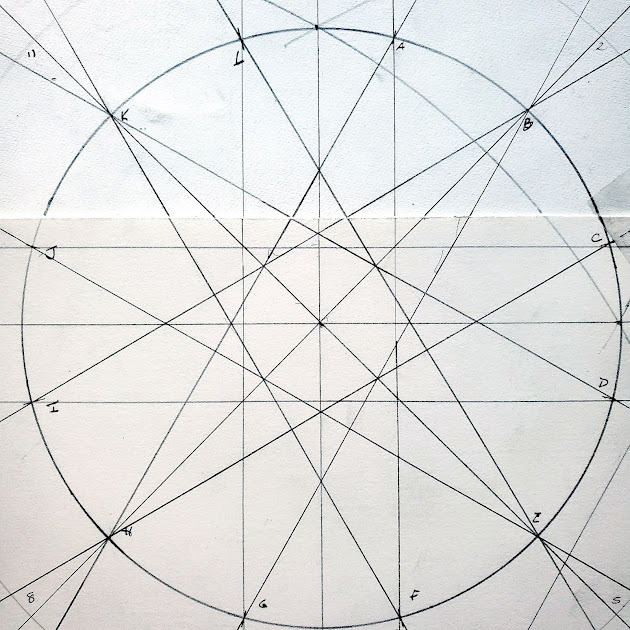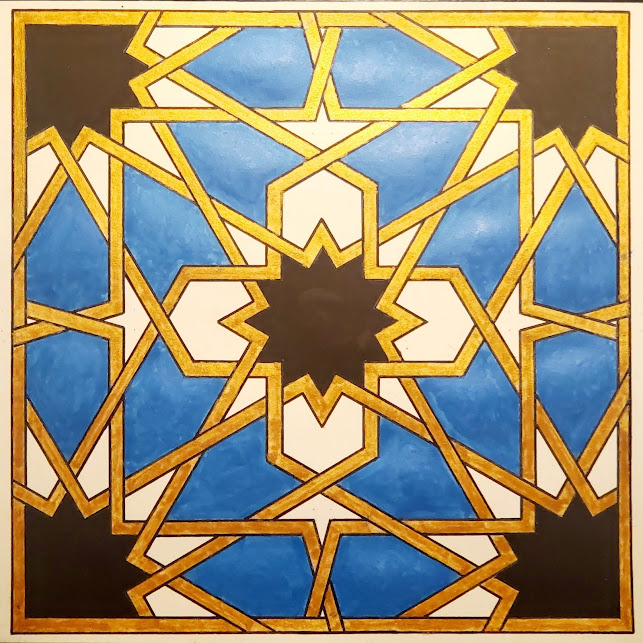Moroccan Geometry: S7 Class: 12-fold with almond (Tanashri bl looza) (تناشرث بل لوزة)
1. Draw a circle the size of the page. This will be divided into 12ths.
Note: If you wish to make the finished design larger so that it takes up the size of the page, the ratio of the circle diameter to the finished height and width of the design should be about 5:3. So if you are working with 12"x18" paper, then attach 2 sheets so that they meet in the middle of the finished page, and if you want the design to be about 11.5" square, then make the diameter of the 11.5x5/3, or about 19.17", thus the radius will be about 9.6". For this, you'll need to use the beam attachment to your compass.
Divide this circle into 4ths by first drawing the horizontal by measuring along the sides of the page with a ruler, then find the vertical by the arc method, using a second compass with a larger radius and the point at 3:00 and 9:00, forming intersecting arcs to define the vertical.
Next, using the compass with the original radius and with the compass point at the 3:00, 6:00, 9:00, and 12:00 points, draw intersecting arcs, extending them to intersect the circle. These intersections with the circle will mark the 1:00, 2:00, 4:00, 5:00, 7:00, 8:00, 10:00 and 11:00 points.
At the point where the arcs from the previous paragraph intersect (indicated by the yellow circles), draw a square frame around the circle. Make a rectangular grid by drawing two lines vertically (from the red intersections at 7:00 & 11:00 and 1:00 & 5:00) and horizontally (from the blue intersections at 2:00 & 10:00 and 4:00 & 8:00) through the division marks closest to the center vertical and horizontal.
2. Draw diagonals through the squares, three diagonals from NW to SE (the main diagonal and diagonals from 12:00 to 3:00 and from 9:00 to 6:00) and three from SW to NE (the center diagonal and diagonals from 12:00 to 9:00 and from 3:00 to 6:00), so that each quadrant is divided into eight triangles.
2. Draw diagonals through the squares, three diagonals from NW to SE (the main diagonal and diagonals from 12:00 to 3:00 and from 9:00 to 6:00) and three from SW to NE (the center diagonal and diagonals from 12:00 to 9:00 and from 3:00 to 6:00), so that each quadrant is divided into eight triangles.
3. Draw a circle in each quadrant. Try to make sure the circles touch each other. Divide each circle into 12 parts by placing the point of the compass at N, S, E, & W, and making 2 marks along the circumference from each point. Further subdivide each circle in to 24 parts by using the dividers to find distance between the diagonal and its adjacent mark that you just made, and then use the dividers to mark those points (8 points, since the diagonals already mark 4 of them) from N, S, E, W.
4. Draw a circle within each of the circles from step 3. The radius is equal to the radius of that circle minus the divider distance between 24ths.
6. Connect the following points of the inner circles: A to F & L to G, extending the lines until they reach another circle. Repeat on all circles. Do the same with the horizontals, C to J, and D to I. Repeat on all circles.
7. Now connect the following points: B to G and A to H, extending the lines to the frame edge or another circle, whichever comes first. Repeat on the diagonals K-D and J-E, then L-E and K-F, and finally C-H and B-I.
5. Number 12 divisions of the outer circle, not like a clock, but as if the circle has been rotated 15 degrees, using the diagonals and the marks created with the dividers. Mark the same points on the inner circle, just marking the points where a straight edge lines up from 1 to 7, 3 to 9, 4 to 10, and 6 to 12. 2 to 8 and 5 to 11 are already connected by the diagonals. Label these points on the inner circle with the letters A-L.
6. Connect the following points of the inner circles: A to F & L to G, extending the lines until they reach another circle. Repeat on all circles. Do the same with the horizontals, C to J, and D to I. Repeat on all circles.
7. Now connect the following points: B to G and A to H, extending the lines to the frame edge or another circle, whichever comes first. Repeat on the diagonals K-D and J-E, then L-E and K-F, and finally C-H and B-I.
Thus, each labeled point on the inner circle will be intersected by 2 lines, and points B, E, H, & K will also be intersected by a previously drawn diagonal from step 2.
8. Use the dividers to find the distance from the center line of any channel from steps 6 and 7, to the outer line, for instance A-F-G-L.
8. Use the dividers to find the distance from the center line of any channel from steps 6 and 7, to the outer line, for instance A-F-G-L.
Using the dividers at this setting, at each of the 4 points where the circles meet, along the line through the centers of the two circles, mark a point on either side of the meeting point. Do this for each of the 4 meeting points.
Now join those points together vertically and horizontally, so that you create two more channels that cross in the center of the page. At this point, make sure that the crossing lines from the upper right circle B-I and from the upper left circle K-D extend to the far edges of the channels you just made. Repeat at the other 3 crossings
Next, mark 4 points along the outer circles, as follows: on the upper left circle, find the division mark between 2 & 3, and connect it to the division mark on the upper right circle between 8 & 9, then from the upper right circle, connect the division mark between 10 & 11 with the division mark on the upper left circle between 4 & 5. Do this at the other crossings in the same way.
9. You may now highlight the lines you’ll keep in the pattern, and detach any excess paper used in creating the design.
10. If you are doing the homework 1, then you’ll need to add a line segment connecting the 2 division marks between each of the crossings created in step 8, just one per circle. In the upper left circle, this means drawing a line from the division marks between 5&6 and 5&4. In the upper right, a line connecting the division marks between 7&8 and 8&9, etc. This will form the boundaries of the sfet shapes that were lherba shapes in the class drawing. Extend the line in both direction to the horizontal and vertical axes of the frame. At this point, you may highlight the lines for the homework 1.
9. You may now highlight the lines you’ll keep in the pattern, and detach any excess paper used in creating the design.
color notes: channels done in 1.9 nib Lamy Al Star pen filled with deep gold Amsterdam metallic ink. The sfets are done in equal parts Amsterdam Brilliant Blue and Pearlescent Blue. White areas to be done in Brilliant White. The Khatem Tanashri are done in Amsterdam Oxide Black.
10. If you are doing the homework 1, then you’ll need to add a line segment connecting the 2 division marks between each of the crossings created in step 8, just one per circle. In the upper left circle, this means drawing a line from the division marks between 5&6 and 5&4. In the upper right, a line connecting the division marks between 7&8 and 8&9, etc. This will form the boundaries of the sfet shapes that were lherba shapes in the class drawing. Extend the line in both direction to the horizontal and vertical axes of the frame. At this point, you may highlight the lines for the homework 1.

























Comments
Post a Comment